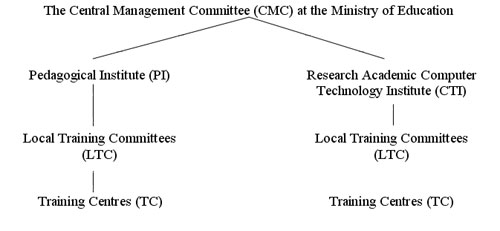
Introduction
The
Ministry of Education is training 76000 Primary and Secondary School teachers
in the use of computers. By the end of 2003, approximately half of the
total number of the teachers in Greek schools will be, for the first time,
officially certified computer literate. The training is provided in 2200
Centers by 5500 Trainers (rounded figures) both specially certified for
this particular purpose by the Pedagogical Institute and the Research
Academic Computer Technology Institute. The training takes place in the
teachers’ free time. There are Training Centers both in the state and
private sectors. The trainees are free to choose the Center, the time
and the trainer of their preference. The vast majority has chosen the
state sector. Two 12-hour daytime Help Desks support the trainees.
The project’s ID
| 3rd Community Support Framework 2000-2006 for Greece | |
Operational
Programme |
“Information Society” |
Action
line1 |
“Education and Culture” |
Measure
1.2 |
“New Technologies in the Educational Process” |
Title: |
“In-service Teacher Training in the Use of Information and Communication Technology (ICT) in Education” |
Management:
|
Ministry of Education and Religious affairs |
Technical
Advisors: |
Pecagogical Institute
(PI) Research Academic Computer Technology Institute (CTI) |
Legally
Responsible: |
Athanasios Tsouroplis, General Secretary, Ministry of Educ. |
General
Manager: |
Dimitrios Papaioannou, Special Secretary Ministry of Educ. |
Central
Management Committee: |
Dimitrios Papaioannou chair. |
| Prof. Nikolaos
Spyrellis member |
|
| Prof. Charalambos
Zagouras member | |
Budget: |
89,661,162 Euro |
Funding: |
75% European Union funds |
| 25% National funds | |
Curriculum
The training program covers the basics in information technology, word
processing, spreadsheets, PowerPoint, Internet and offers an overview
of educational software.It gives the teachers the opportunity to get acquainted
with ICT and use it productively to improve
their teaching methods, to be able to search for new sources of knowledge,
and participate in new educational communities for professional development.
It is a 48-hour program, in groups of 10 trainees, spread over 8 consecutive
weeks in two 3-hour sessions per week. The trainees are provided with
educational material for home practice. They are also partly funded, with
close to 600 euros, for the purchase or updating of home computers.
Basic Structure

Procedure
The Central Management Committee at the Ministry
announces the dates and sends out the call for participation. The Training
Centers submit to the Local Training Committees their timetable of the
standardized course(s) they offer. The Local Training Committees inform
the schools. The teachers apply at the school level. The applications
are processed by the Local Training Committees. The places are allotted
by computerized draw. At the end of the course the teachers who have attended
at least 90% of the training course are issued a certificate of attendance
and are given half of the 600-euro funding. When the teachers feel they
are ready for certification they sit an on-line 3-hour test. They can
sit it a maximum of 3 times. On certification they receive the second
half of the 600-euro funding. The Research Academic Computer Technology
Institute is responsible for the certification scheme. It has also
developed a Management Information System (MIS) to completely digitalize
the project.The Pedagogical Institute is responsible for processing the
applications to become Training Centers, Trainers, and Local Training
Committee members.
The Course
Title
of the Unit |
Content |
Introductory
concepts, use of PC |
1.
Data and Information |
Word
processing |
1.
Get used to the working environment |
Spreadsheets |
1.
Get used to the working environment |
PowerPoint |
1.
Get used to the working environment 2. Formatting a presentation 3. Copying, moving, deleting the content of a slide 4. Formatting a slide 5. Print preview – print 6. Slide show and slide transition effects 7. Inserting objects (pictures, drawing) |
Internet
and communications |
1. Computer
networks and the Internet 2. Using software for browsing, accessing Internet locations – using the structure of hypermedia of www 3. Navigation, collecting and managing information 4. Search engines 5. E-mail (the various fields of an email message, managing email messages, inserting file attachments) 6. Virus protection |
Educational
software |
An overview of the educational software |
Structure of the project (Image)
